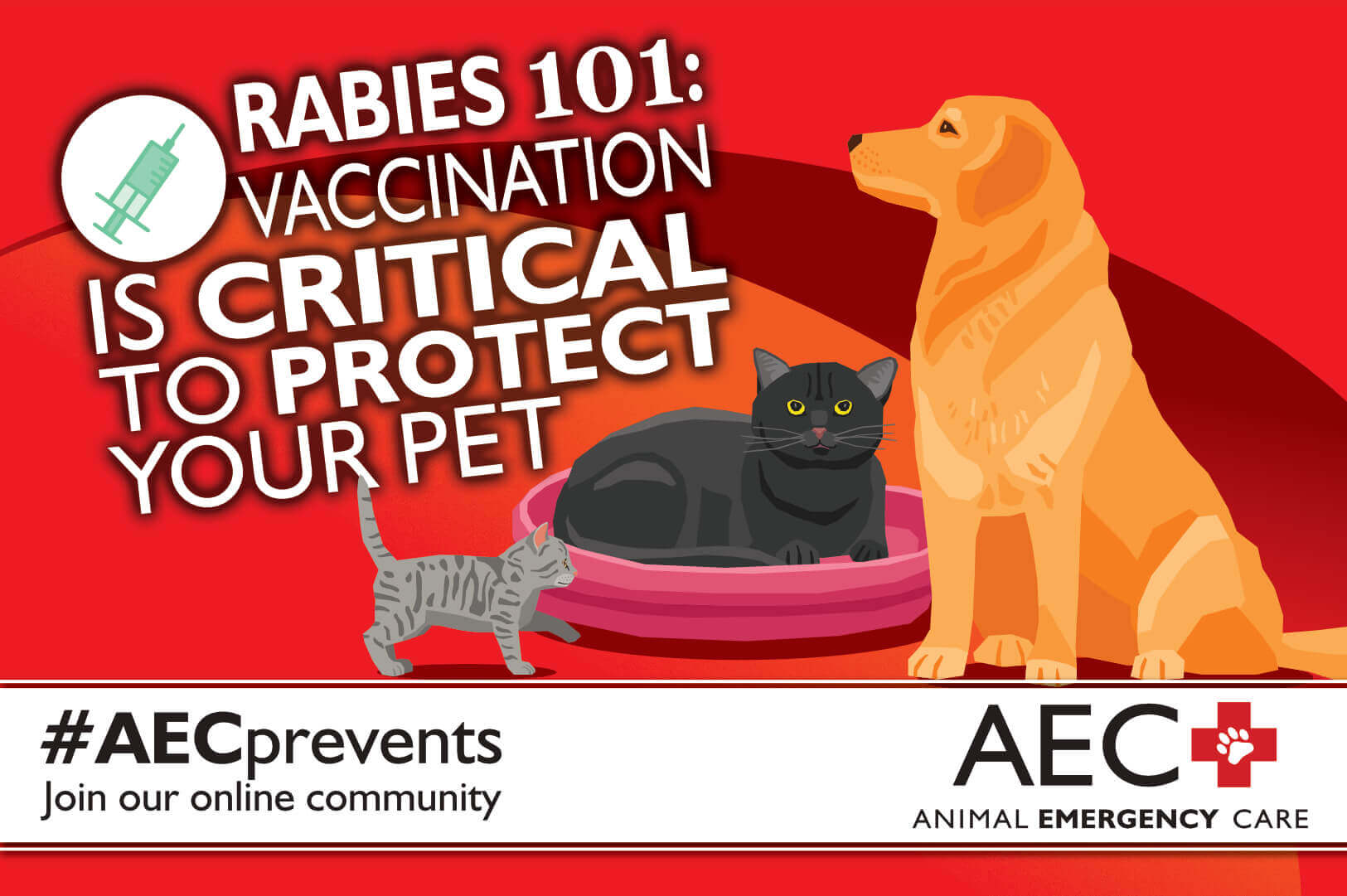Rabies has always been one of the most feared infections in the animal world. Many are familiar with the story of Old Yeller and the beloved dog’s sad demise after rabies exposure. Great strides have been made since then, and vaccination has mostly eliminated the fear of losing a beloved pet to rabies. However, more than 50 dogs and 250 cats will die each year from rabies in the U.S. Our Animal Emergency Care team wants to ensure your pets are protected against this dangerous virus.
What is rabies in pets?
Rabies is a deadly disease caused by a single-stranded RNA virus that attacks the nervous system of mammals. The virus cannot survive in the environment without a host and requires direct contact with body secretions to spread. The virus is spread mostly through contact with saliva after an infected animal bite. Less commonly, rabies is spread if saliva contacts an animal’s open skin wound or the eyes, nose, or mouth. Rabies is most commonly transmitted to pets by wildlife species including skunks, bats, raccoons, foxes, and coyotes. Indoor pets are at risk of infection if a bat or other wildlife accidentally comes indoors.
What are rabies signs in pets?
Rabies virus signs may not be apparent for several months after infection with an average virus incubation period of 21 to 80 days in dogs and 28 to 42 days in cats. The rabies virus attaches to their muscle cells for several days before penetrating their nerves and then moves throughout the nervous system until reaching the brain. The rabies virus is present in all secretions and transmissible to other animals including humans once it has settled in the brain. Clinical signs vary depending on the location in a pet’s body, but an animal has no chance of survival once they are showing rabies signs. Rabies infection stages and signs:
- Prodromal stage —Two to three days after symptoms start pets may experience a personality change such as a friendly animal becoming shyer or a shy pet becoming uncharacteristically affectionate. Their bark or meow may change. Most pets will lick and scratch near the inflicting bite.
- Excitative stage — Most dogs will not experience this excitative stage which is often referred to as the “mad dog stage.” Pets may experience hallucinations and attack kennel bars or invisible objects.
- Paralytic stage — The classic rabies signs such as foaming at the mouth occur during the paralytic stage. Animals lose the ability to swallow, and the muscles that control breathing become paralyzed. They die shortly after reaching this stage.
Diagnosis and treatment of rabies in pets
There is no treatment for rabies once signs are present, and animals showing signs will need to be euthanized and tested. A definitive rabies diagnosis can be made only after death. Many protocols are in place and specific steps are required to address an animal who has bitten another pet or person. Regional and local laws vary, so check this site for region-specific laws and ensure you follow your local health department’s instructions. Additionally, contact your family veterinarian immediately if your pet has been bitten, especially by wildlife. They will check your pet’s rabies vaccine status and treat any bite wounds on your pet. Bite wounds can lead to systemic infections in your pet and often require cleaning, antibiotic treatment, pain control, and even surgery in some cases.
Financial planning for your pet’s rabies treatments
Treatment for bite wounds and quarantining your pet in an approved facility can lead to high veterinary expenses. Rabies vaccinations are also required by law as part of your pet’s preventive care. However, pet insurance can alleviate veterinary costs including vaccinations. Many policies include coverage for preventive care as well as unexpected injury. Ensure you purchase a policy when your pet is young, and before they need emergency veterinary care. Pet health savings accounts are also a great way to plan ahead for your pet’s medical care. Financial institutions that offer these accounts typically provide many benefits including discounts on pet health insurance. Alternate payment methods such as Care Credit and Scratch Pay can also help by spreading out payments of a large veterinary bill.
Rabies prevention in pets
Rabies vaccinations are required by law for all dogs, cats, and ferrets in most communities. The vaccine is vital to prevent infection and subsequent death of your pet should they come in contact with an infected animal. Ensure you keep pets on a leash outside to prevent them from roaming to limit their exposure to potentially infectious wildlife or pets. Additionally, avoid leaving out garbage that may attract wildlife. Report any animals you observe behaving abnormally.
Call our office and bring your pet for immediate care if another animal bites them. Visit your family veterinarian regularly and keep your pet’s rabies vaccination current to prevent this deadly disease. #AECprevents
Sources:
https://veterinarypartner.vin.com/default.aspx?pid=19239&id=4951479
https://www.avma.org/resources/public-health/rabies-and-your-pet


